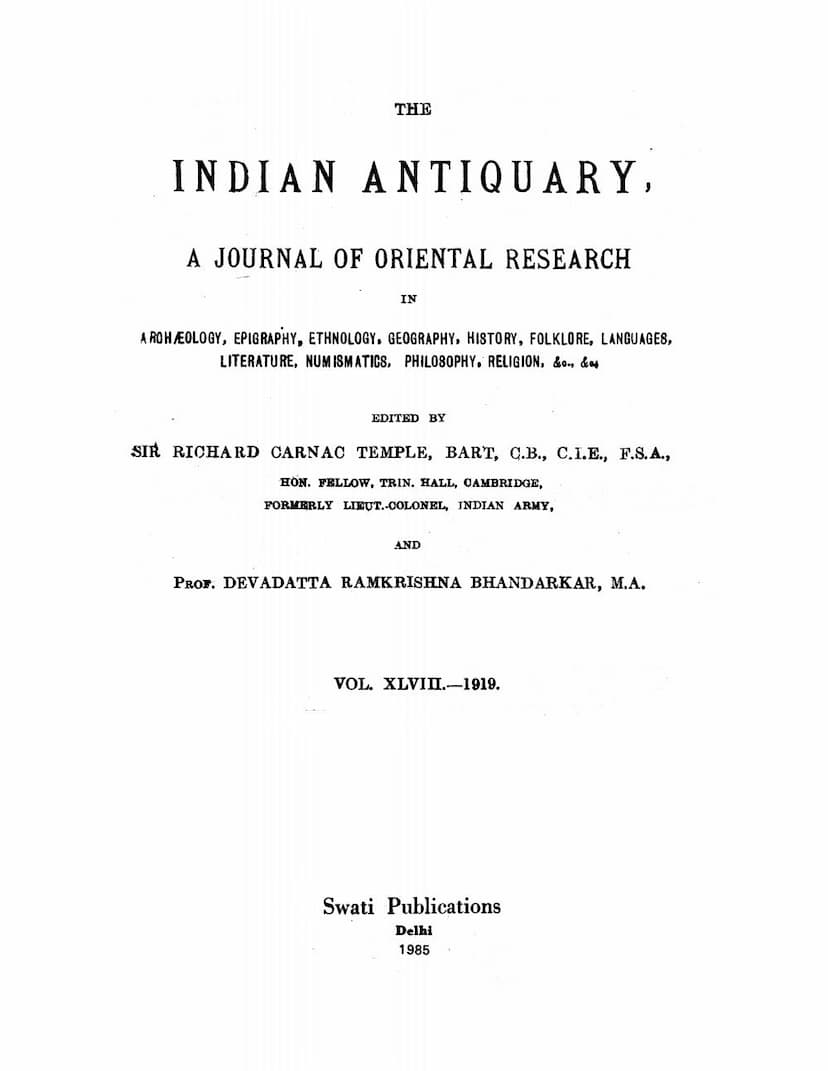Indian Antiquary Vol 48
Added to library: September 1, 2025

Summary
The provided text is an issue of the Indian Antiquary: A Journal of Oriental Research, Volume XLVIII, published in 1919. This volume contains a collection of articles and miscellanea on various aspects of Indian history, archaeology, linguistics, and culture.
Here's a summary of the key themes and discussions present in the volume, focusing on aspects relevant to Indian history and archaeology:
Key Themes and Discussions:
-
Chronology and Dynasties: A significant portion of the volume is dedicated to establishing and refining the chronology of various Indian dynasties.
- The Chronology of the Western Châlukyas of Kalyani: This extensive article by A. Venkatasubbaiah meticulously details the reigns, dates, feudatories, and officers of the Western Chalukya rulers from Vikramaditya IV to Somesvara IV, providing a detailed timeline based on epigraphic evidence.
- The Hun Problem in Indian History: Professor S. Krishnaswami Aiyangar analyzes the historical presence and impact of the Huns in India, discussing their origins, their interactions with Persian and Roman empires, their incursions into India during the Gupta period, and their possible mention in Indian literature like Kalidasa's Raghuvamsa.
- The Life and Times of Chalukya Vikramaditya: This multi-part article by A. V. Venkatrama Ayyar delves into the ancestry, birth, training, military exploits, and political relationships of Chalukya Vikramaditya VI, offering critical analysis of historical sources and poetic accounts.
- The Lâkshmanasena Era: N. G. Majumdar re-examines the Lakshmanasena era, discussing its starting point and challenging theories that suggest the existence of multiple eras related to this Sena king, particularly in light of Bodh Gaya inscriptions.
- The Jogimara Cave Inscription: K. P. Jayaswal offers a re-interpretation of this inscription, arguing against previous readings and proposing a new understanding of its content related to an official order.
- Alleged Saisunaga Statues: R. C. Majumdar and R. D. Banerji engage in a scholarly debate regarding the epigraphic and artistic dating of two Patna statues, challenging K. P. Jayaswal's identification of them as Saisunaga emperors.
-
Inscriptions and Epigraphy: Several articles focus on the decipherment, interpretation, and historical significance of specific inscriptions.
- The Panamalai Rock-Temple Inscription of Rajasimha: K. G. Sankara Aiyar provides a new reading and interpretation of this inscription, offering corrections to previous scholarly analyses.
- Patna Museum Inscription of Jayasena: N. G. Majumdar edits and discusses this inscription, shedding light on the hitherto unknown kings Buddhasena and Jayasena and their rule over Bodh Gaya.
- The Hathigumpha Inscription of Kharavela: R. C. Majumdar presents a second note on this inscription, critiquing recent interpretations and proposing alternative readings and chronological placements.
- Epigraphia Notes: N. G. Majumdar also provides notes on a passage in the inscriptions of the Maitrakas of Valabhi and on the location of Sravasti and Tarkkari.
-
Linguistics and Language:
- The Intervocalic Consonants in Tamil: Jules Bloch analyzes phonetic changes in Tamil, drawing parallels with Indo-Aryan languages and discussing the historical development of its consonant system.
- Paisachi Prakrit: S. P. V. R. Aryavaragunga discusses the classification of Paisachi dialects as presented by Sanskrit grammarians like Ramatarkavagisa and Markandeya, noting discrepancies and potential origins.
- South Andaman Language: E. H. Man's ongoing "Dictionary of the South Andaman Language" is continued in supplements.
-
Numismatics: K. N. Dikshit presents numismatic notes detailing rare types of coins, including Indo-Greek (Andragoras), Western Kshatrapa (Jayadaman, Rudradaman I), and Muhammadan (Gujarat Sultans) coins.
-
Cultural and Religious History:
- Ancient Hindu Coronation and Allied Ceremonials: Narendra Nath Law provides a comprehensive account of coronation rituals (Rajyabhisheka and Yauvarajyabhisheka) in ancient India, drawing from Vedic literature, epics, and Puranas, and comparing them with European coronation practices.
- The Dekkan of the Satavahana Period: Professor D. R. Bhandarkar discusses the religious, social, and economic conditions of the Dekkan during the Satavahana period, highlighting the flourishing state of Buddhism and Brahmanism, the adoption of Hindu names by foreign tribes, and the social stratification of the time.
- New Light from Prehistoric India: Professor Panchanan Mitra presents findings on prehistoric scripts and signs on Indian neoliths, suggesting possible connections to Egyptian and other ancient scripts and discussing the implications for the origin of Indian script.
-
Folklore and Miscellanea:
- Notes on Currency and Coinage among the Burmese: Sir Richard Temple continues his extensive study on Burmese currency and coinage, detailing various forms of lump currency (gold, silver, lead, tin, spelter), their origins, and historical records related to them.
- Episodes of Piracy in the Eastern Seas, 1519 to 1851: S. Charles Hill begins a series detailing various instances of piracy, including early Indian pirates, the Portuguese fight with a pirate near Ceuta, Japanese piracy in Chinese waters, and the activities of European pirates in the Eastern Seas.
- Tipu Sultan's Letters at Sringeri: S. N. Sen discusses letters shedding new light on Tipu Sultan's interactions with the Sringeri Matha and the Mahratta invasions, attempting to reconcile seemingly contradictory historical accounts.
- The Hun Problem in Indian History: This article, as mentioned earlier, is a significant piece on the historical impact of the Huns.
- Book Notices: Reviews of "The Harshacharita of Banabhatta," "The Dream Queen," and "Sources of Vijayanagar History" are included, providing critical assessments of these publications.
- Miscellanea: Short notes on the term "Samaja," "Pratiharas in Southern India," "Survival of the Term Karori," and "Tushaspha, the Yavanaraja" are also present.
The volume reflects a period of active historical and archaeological research in India, with scholars actively engaging with primary sources like inscriptions, coins, and ancient texts to reconstruct India's past. The discussions often highlight scholarly debates and the challenges of interpreting historical data from ancient and medieval periods.